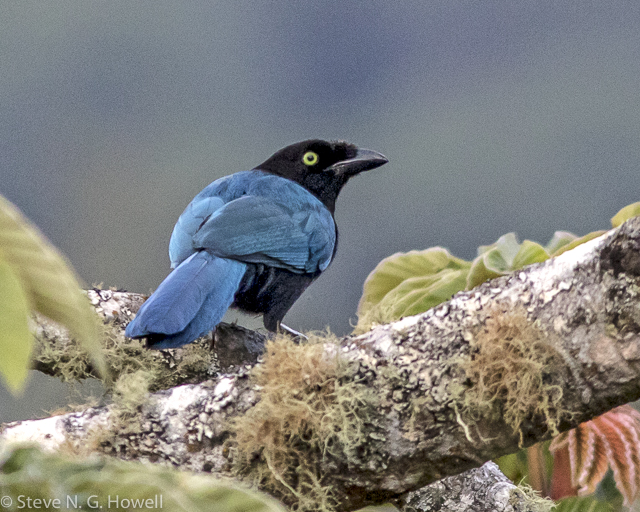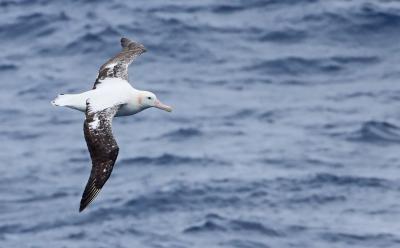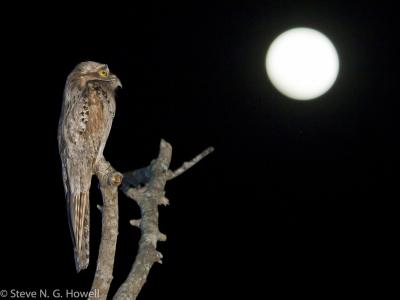Honduras
The Hidden Gem of Central America
-
Feb 11-20, 2027
Steve Howell
Honduras is one of the least-known countries in the Americas and remains stubbornly off the beaten track. However, with specialty birds such as Keel-billed Motmot, Wine-throated Hummingbird, Resplendent Quetzal, Lovely Cotinga, and the endemic Honduran Emerald, plus comfortable lodges and beautiful scenery, visitors will quickly realize that the country provides a great introduction to Neotropical birding.
Boasting more square miles of protected area than Costa Rica, the national parks and preserves of Honduras shelter over 700 species of birds. Our tour will cover a wide selection of these protected habitats, from the misty cloud forests of La Tigra National Park to the marshes of Lake Yojoa and the lowland coastal jungles of the Caribbean coast.
Day 1: Our tour begins in Comayagua, where the new international airport is situated. If there is time, we’ll do some late afternoon birding nearby. Night in Comayagua.
Day 2: After a morning birding the dry interior habitats near Comayagua, where species include Streak-backed Oriole, Nutting’s Flycatcher, and White-lored Gnatcatcher, we’ll drive to our hotel in the pine-oak foothills outside Tegucigalpa and near La Tigra National Park. Afternoon birding around our hotel may produced birds such as Bushy-crested Jay, Yellow-backed Oriole, Blue-and-white Mockingbird, and Yellow-throated [White-naped] Brushfinch. Night near Tegucigalpa.
Day 3: La Tigra National Park offers excellent mountain birding virtually on the outskirts of Tegucigalpa and we’ll spend most of the day in this beautiful area. The network of roads and trails will enable us to see many of Central America’s higher-elevation species. These include a fine variety of hummingbirds, such as Wine-throated Hummingbird, the range-restricted Green-breasted Mountain-gem, and possibly Garnet-throated Hummingbird. Other species we might encounter include Emerald Toucanet, Resplendent Quetzal, Mountain Trogon, Spotted and Strong-billed Woodcreepers, Barred Forest-Falcon, Mountain Elaenia, Rufous-browed Wren, Slate-colored Solitaire, Rufous-collared Thrush, and Crescent-chested Warbler. Night near Tegucigalpa.
Day 4: We’ll spend the morning birding near our hotel, looking for things we may have missed the previous day before driving northwest to Panacam Lodge at the edge of Cerro Azul Meámbar National Park on the east side of Lago de Yojoa. The lodge grounds are rich in birds, and we’ll be looking especially for the scarce and local Keel-billed Motmot. The hummingbird mix here is somewhat different from that at La Tigra and may include the striking Long-billed Hermit and impressive Violet Sabrewing. Night at Panacam Lodge.
Days 5-6: We’ll have two full birding days based out of Panacam. One day we’ll drive to a recently discovered site for the endemic Honduran Emerald, which has a very localized distribution in scattered rain-shadow habitats. These dry habitats have an interesting mix of species that also include Spot-bellied Bobwhite, Elegant Trogon, and Green Jay. We’ll also bird the nearby Lake Yojoa, where we should see an array of waterbirds including Fulvous and Black-bellied Whistling-Ducks, Northern Jacana, and perhaps Ruddy and Gray-breasted Crakes. The boardwalk at the Los Naranjos archaeological site offers excellent birding, with species such as Laughing Falcon, Gartered Trogon, Green-breasted Mango, Streak-headed Woodcreeper, Rufous-breasted Spinetail, Rufous-backed Wren (the endemic Honduran race, likely a cryptic species), and a wide range of wintering North American migrants. The grounds of Panacam and the entrance road are home to species including Keel-billed Toucan, Collared Aracari, Northern Barred and Wedge-billed Woodcreepers, Crimson-collared Tanager, Green-backed Sparrow, Prevost’s Ground-Sparrow, and perhaps even a Northern Royal Flycatcher or Mayan [Black-faced] Antthrush. Nights at Panacam.
Day 7: We’ll have a last morning to bird around Panacam before heading north to the coastal lowlands for our last three nights and a different suite of habitats and birds. Night near Tela.
Days 8–9: Several excellent birding locations lie within easy reach of our lodge. One morning we’ll visit Lancetilla Botanical Gardens, home to a rich selection of forest and edge birds including Rufous-tailed Jacamar, Black-headed Trogon, Great Antshrike, Uniform Crake, Chestnut-colored and Black-cheeked Woodpeckers, White-collared and Red-capped Manakins, Long-billed Gnatwren, Scarlet-rumped and Golden-hooded Tanagers, and Olive-backed Euphonia. We’ll keep a careful eye on the sky for various raptors, that might include include the fancy White Hawk and impressive King Vulture. Another site we’ll visit is the Cuero y Salado Wildlife Refuge, where a boat trip through the wetlands can produce Bare-throated Tiger-Heron, Boat-billed Heron, Sungrebe, American Pygmy Kingfisher, Black-crowned Antshrike and perhaps even a roosting Northern Potoo. One afternoon we’ll visit the Rio Santiago resort to watch swarms of hummingbirds of up to a dozen species. These will likely include the stunning White-necked Jacobin, dazzling Crowned Woodnymphs, and with luck the distinctive Band-tailed Barbthroat, plus there’s always a chance for things like Lovely Cotinga or roosting Spectacled Owl. Nights near Tela.
Day 10: Depending on our flight departure times, there may be a chance to enjoy another morning birding near the lodge before we depart for San Pedro Sula, where the trip concludes with flights home.
Note: The information presented below has been extracted from our formal General Information for this tour. It covers topics we feel potential registrants may wish to consider before booking space. The complete General Information for this tour will be sent to all tour registrants and of course supplemental information, if needed, is available from the WINGS office.
ENTERING HONDURAS: Honduran authorities require a valid passport good for six months after the date of entry and with at least one blank page for an entry stamp. Visas are not required for U.S. and Canadian citizens but you must show proof of return or onward travel. Citizens of other countries may need a visa and should check their nearest Honduran embassy. If required by the embassy or visa-granting entity, WINGS can provide a letter for you to use regarding your participation in the tour. As of 2024, UK citizens do require a visa for to visit Honduras.
It is always a good idea to take photocopies of your passport and air ticket with you when traveling abroad. They can prove invaluable in helping you get replacements if your original documents are lost or stolen. You should pack the photocopies separately from the originals.
LEAVING HONDURAS: A departure tax is due at the airport in San Pedro Sula upon departure, although it is often included in the price of your ticket. In 2022 this fee was about USD$40.00.
COUNTRY INFORMATION: You can review the U.S. Department of State Country Specific Travel Information at https://travel.state.gov/content/travel/en/international-travel/International-Travel-Country-Information-Pages/Honduras.html.
INTRODUCTORY MEETING: Flights from the US typically arrive in Tegucigalpa/Comayagua in the afternoon or evening. We will have an introductory meeting over dinner at our hotel near the entrance to La Tigra National Park. This informal meeting gives the leader the opportunity to introduce everyone to each other and to let you know generally what to expect on the trip – pace of the tour, daily routine, etc. If you choose to arrive a day early, please ask us to arrange an extra night’s lodging for you at our hotel.
PACE OF THE TOUR: This tour is not overly strenuous but days can seem long. Most days will begin with breakfast at about 5-5:30 am. All of our walks will be at a slow pace with opportunities to pause for a rest, but you should still be in good physical condition to participate in all activities; there is, however, usually the option of sitting out one or more of the hikes, and afternoons can often be spent relaxing at the lodges. Throughout we will have sit-down midday meals in a hotel or restaurant, followed by more relaxed birding in the afternoon and dinner.
On the hikes at La Tigra, sturdy footwear is essential and a walking stick will be very helpful. These walks require a good degree of fitness.
HEALTH: The Centers for Disease Control and Prevention (CDC) recommends that all travelers be up to date on routine vaccinations. These include measles-mumps-rubella (MMR) vaccine, diphtheria-tetanus-pertussis vaccine, varicella (chickenpox) vaccine, polio vaccine, and your yearly flu shot.
They further recommend that most travelers have protection against Hepatitis A and Typhoid. Please contact your doctor well in advance of your tour’s departure as some medications must be initiated weeks before the period of possible exposure.
The most current information about travelers’ health recommendations can be found on the CDC’s Travel Health website at http://wwwnc.cdc.gov/travel/destinations/traveler/none/honduras .
Malaria: Malaria exists in rural areas below 5000’ elevation. This may include areas we visit on day trips. You should discuss with your doctor the best preventive measures to take. Anti-malarial drugs effective in Central America include Primaquine, Atovaquone/proguanil, chloroquine, doxycycline and mefloquine. Using insect repellent and wearing long pants and sleeves to prevent mosquito bites is also effective as a preventive measure.
Yellow Fever: Yellow fever is not a disease risk in Honduras, but travelers arriving from a country where yellow fever is present must present proof of a current vaccination.
Smoking: Smoking is prohibited in the vehicles or when the group is gathered for meals, checklists, etc. If you are sharing a room with a non-smoker, please do not smoke in the room. If you smoke in the field, do so well away and downwind from the group. If any location where the group is gathered has a stricter policy than the WINGS policy, that stricter policy will prevail.
Miscellaneous: Biting insects and arachnids are typically scarce in the mountains, although mosquitoes and biting gnats can be locally numerous inside the forest at any elevation. Mosquitoes can be numerous in the lowlands, especially at Lancitilla Botanical Gardens. Long sleeves, long pants and careful application of repellent provides good protection, and the leader will advise you when it will be necessary. In general, a repellent should contain 30% of the active ingredient diethyltoluamide (DEET). Care must be taken as DEET can be corrosive to optics coatings and older rubber-armoring on binoculars and scopes. Camping supply stores and outfitters carry some reasonably effective alternatives which contain natural products and aren’t corrosive.
Products containing tick- and chigger-repelling chemicals are particularly effective. Camping supply stores sell such a product containing permethrin 0.5%. This non-staining, odorless chemical is non-toxic to humans and protective on clothing through several launderings (it must be applied to your clothing a day or two before the tour starts).
The sun can be very strong, making a hat a necessity at most sites and sunglasses useful.
You should bring adequate supplies of all prescription and special medications, as they are not likely to be conveniently available in the areas this tour visits. Some travelers to Honduras experience digestive upsets; consult with your physician about the need to bring with you anything beyond over-the-counter diarrhea medication and drink only bottled water and other beverages during your visit.
CLIMATE: Rain showers are always possible, especially near the coast and at Panacam. At La Tigra National Park the lows should be in the 50s and highs in the 70s. Elsewhere it will be warmer. A sweater, light jacket, and possibly light gloves will probably add to your comfort at La Tigra.
Weather in the Honduran lowlands during the tour is likely to be somewhat warm with temperatures ranging from the 60s or low 70s in early morning to the 80s or even low-90s in the afternoon. Rain showers are possible at any time and the air is constantly heavy with humidity, so light, quick-drying clothing is recommended. Even in April, however, northern fronts (nortes) can arrive with cooler temperatures, strong winds and steady rain.
ACCOMMODATIONS: The hotel at Comayagua is standard and conveniently located for our birding and airport transfers. The rooms at the lodge near the entrance to La Tigra National Park are a little rustic but comfortable, and set amid forest—Bushy-crested Jays sometimes roam through the grounds! The lodge at Panacam has comfortable rooms with fans and a/c, although it is usually cool enough that this is not needed. Our hotel near Tela is at a beach resort hotel with swimming pool and other amenities.
FOOD: The food in Honduras is of excellent quality. Our hotel breakfasts generally consist of eggs, bread, fruit, yogurt, fried plantains, black beans, fresh juice and coffee (tea and decaffeinated coffee are not widely available). Midday meals and dinners usually feature chicken or beef or fish plus tortillas, black beans or pasta. WINGS tours are all-inclusive and no refunds can be issued for any missed tour meals.
Food Allergies/Requirements: We cannot guarantee that all food allergies can be accommodated at every destination. Participants with significant food allergies or special dietary needs should bring appropriate foods with them. Tour meal times are approximate. Participants who need to eat according to a fixed schedule should bring supplemental food. Please contact the WINGS office if you have any questions.
TRANSPORTATION: Transportation during the tour is by air-conditioned minibus with a professional driver. Participants should be able to ride in any seat in our tour vehicles.
2025 Narrative
From bromeliad-laden highland cloud forests with cryptic Singing Quails to dry interior scrub with retiring Lesser Ground Cuckoos, and from rainforests with colorful Keel-billed Toucans to a delightful boat ride with reclusive Boat-billed Herons, this exciting tour sampled the avian riches of a little-known country. Highlights were many, including the tiny Wine-throated Hummingbird; the endemic Honduran Emerald and ‘Honduran Wren’; the always-popular motmot quartet (Turquoise-browed, Lesson’s, Keel-billed, and Tody); obliging Double-striped Thick-knees; an impressive Collared Forest Falcon; that cryptic Northern Potoo; a superb Sungrebe; varied colorful tanagers; and an abundance of migrant warblers—from Golden-winged to Golden-cheeked! This year’s weather inland was a little cooler and rainier than usual, becoming decidedly hot and humid in the Caribbean lowlands. But everywhere we went we found friendly and welcoming people and delicious food—and then, all too soon it was over.
All arrived on time and, after a short transfer to the hotel and time for some rest, we ventured out for a little late afternoon birding in the dry interior Comayagua Valley. The first official trip bird was Double-striped Thick-knee —what a way to start! Other notables were good views of the usually elusive Lesser Ground-Cuckoo, handsome Stripe-headed Sparrows and White-lored Gnatcatchers, and a bromeliad growing on a large Opuntia-like cactus. Then it was time for a good dinner and sleep.
An early start the first morning found us at a remnant patch of dry tropical forest, where the trees were dripping with orioles, along with other species ranging from Collared Forest Falcon and Ferruginous Pygmy Owl to Turquoise-browed Motmot and Squirrel Cuckoo. A short walk produced a pair of Common Black Hawks, a Collared Aracari, and the good studies of the cryptic Salvadoran Flycatcher, only recognized as its own species in the 2000s! The drive to and through Tegucigalpa gave us a better sense of the country before arriving at our rooms in delightfully clear mountain air for a filling lunch and siesta. Late afternoon near our lodging produced a good selection of wintering North American warblers (including Golden-winged and Black-throated Green) along with residents such as the regional endemic Bushy-crested Jay and Gray-headed Vireo, plus the handsome Chestnut-capped Warbler and a point-blank ‘Double-toothed’ (aka Flame-colored) Tanager. A fine dinner rounded off the day as a light rain began to patter and lull us to sleep.
Dawn of the second morning found us enshrouded in fog as we drove up to La Tigra National Park, where almost the first birds we saw were a couple of White-faced Quail-Doves walking down the road! But then, the birding was strikingly quiet, although a pair of Emerald Toucanets, a singing (but unseen!) Mountain Trogon, a few Slate-colored Solitaire songs, and the very local Green-breasted Mountain-gem were noted before the rain started. Despite the rain and wind, our hike in search of Wine-throated Hummingbirds was very successful, although not without appreciable effort; and scope views of singing Singing Quail were an added bonus. Following a good lunch, with delicious mora juice, we opted to persevere with the cloud forest and finally found some flocks, before the rain let up as we left the park! Afternoon roadside birding proved extremely productive, however, with species ranging from handsome Acorn Woodpeckers and blatant (!) Blue-and-white Mockingbirds and Yellow-throated [White-naped] Brushfinches to the recently split Guatemalan Flicker and a veritable blizzard of warblers—at and below eye-level: a pair of Painted Whitestarts, plus Hermit, Townsend’s, Black-throated Green, Grace’s, MacGillivray’s, Wilson’s, and Black-and-white all vied for our attention and made for a wonderful conclusion to a varied birding day. Another fine dinner with great local fruit juice prepped us for sleep before our longest travel day.
We gave the cloud forest a second chance, and instead of fog and rain experienced scudding clouds and howling wind—but at least we could see birds in decent light! Amazingly, a White-faced Quail-Dove showed well again, then Emerald Toucanets that really looked green! Mountain Trogons took some effort—well worth it; the mixed flocks held a briefly seen Golden-cheeked and handsome Crescent-chested Warblers; Slate-colored Solitaires were promoted to visible; and we ended with a pair of impressive Strong-billed Woodcreepers. Then it was mostly travel—although a gas-station bathroom stop produced beautiful sunlit views of Collared Aracari plus Yellow-winged and Blue-gray Tanagers—before arriving at Panacam Lodge, our base for the next 3 nights. Birds on the grounds in late afternoon included Crested Guan, Keel-billed Toucan, Northern Barred Woodcreeper, and Violet Sabrewing—evidence that we had shifted from an interior to a Caribbean-slope avifauna—while a handsome Mottled Owl after dinner rounded off the day.
Our first birding day based at Panacam we visited the delightful Finca Luna del Puente, starting with elusive Green-backed Sparrows and a roosting Northern Potoo, Birding the finca trails produced numerous warblers, the stunning Crimson-collared Tanager, and—finally!—a pair of Tody Motmots (not to mention Turquoise-browed and Lesson’s Motmots as well!). The recently set up feeding station allowed fabulous views (and photo ops) of sundry species, including eye-popping Green Jays and Spot-breasted Orioles, and even a Gray-chested Dove. Shade coffee and chocolate are products of the finca and we enjoyed sampling both. After lunch it was on to a subtly drier habitat where, with some work, we found the endemic and range-restricted Honduran Emerald, along with males of both Blue-winged and Golden-winged Warblers plus a bright male of the hybrid combo known as ‘Brewster’s Warbler,’ and a tree loaded with euphonias and Yellow-winged Tanagers—overall quite the day!
A full morning at Lake Yojoa was indeed full, with about 100 species and lots of birds, ranging in size and color from Bare-throated Tiger-Heron to Least Grebe, and from Keel-billed Toucan to Northern Bentbill, plus handsome Northern Jacanas and some 15 species of warblers, headlined by the elusive Kentucky and a very obliging Tropical Parula. After lunch we took a well-earned siesta before birding around the lodge, where highlights included Collared Trogon and a sneaky little White-breasted Wood-Wren—plus more motmots.
The next morning dawned cloudless and soon became hot, finally! We enjoyed a leisurely hour birding around the lodge and found our fourth motmot—the local Keel-billed —before heading out along the entrance road, where numerous species included snappy male White-collared Manakins, the visually elusive little Slate-headed Tody-Flycatcher, and a pair of Barred Antshrikes. After lunch we headed on to Tela by late afternoon, via a productive stop at the El Progreso sewage ponds: among the army of Black-necked Stilts we found both yellowlegs plus Solitary and Stilt Sandpipers, while the marshy vegetation held the under-regarded White-throated Flycatcher.
The next morning found us birding at Lancetilla, where the high diversity of species meant we never knew what might appear: highlights included an oddly bronzy-looking Rufous-tailed Jacamar in the early light, sundry trogons and woodcreepers, a pair of foraging Great Antshrikes, the spectacular Montezuma Oropendola ‘city,’ and a brilliant male Scarlet-rumped Tanager. From Lancetilla we headed to lunch at Corinto, where an unhurried afternoon walk produced the sought-after Lovely Cotinga plus handsome male Olive-backed Euphonias and Green Honeycreeper.
Our earliest morning start was well worth it, with a wonderful boat trip at the Cuero y Salado wildlife refuge, where highlights ranged from Ringed Kingfishers to Chestnut-colored Woodpeckers, from sleepy Boat-billed Herons to endearing little Proboscis Bats, followed by a delicious lunch and refreshing cold juice in the welcome shade. Building clouds produced just a few drops of rain on our return boat commute, which was punctuated by superb views of the odd little Sungrebe —which is not a grebe and does not like the sun! We returned to the hotel in good time for packing and relaxing before dinner and a final bird list to recap our amazing adventures to some beautiful places, with a stunning selection of birds. Thanks to all for coming and for making it such a wonderful trip.
- Steve Howell
Maximum group size seven with one leader.

















-facebook.jpg)


